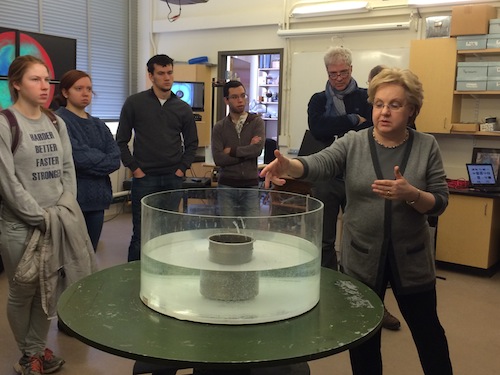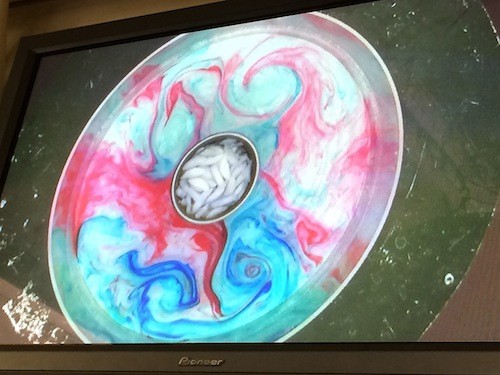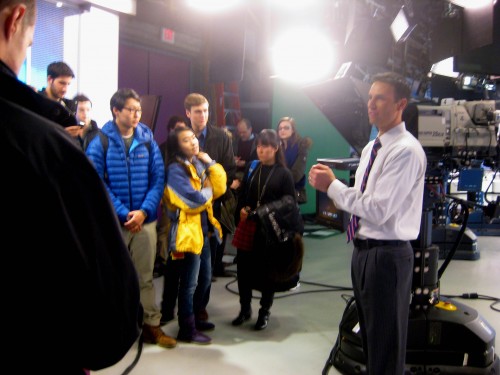PAOC Spotlights
Weathering the 2014 IAP
It’s been a bone-chilling two weeks here in Cambridge during MIT’s Independent Activities Period (IAP), and thanks to Course 12.310 ‘An Introduction to Weather Forecasting,’ twenty new amateur forecasters can tell you that the northwest winds behind last week’s stubborn Arctic cold front kept temperatures bitterly low and look for signs of warmer weather to come.
This meteorological IAP course, always offered between semesters at MIT, is a useful way to learn about the principles of fluid dynamics that govern the atmosphere’s movement. In lectures, real forecasting exercises, and a trip to WBZ TV’s on-air weather center, students gain insight into where the daily weather prediction on their phone apps comes from and even learn to make their own.

“Our aim is that students come to understand that weather forecasting is not guessing and is based on real science,” says Lodovica Illari, senior lecturer in synoptic meteorology in the Program in Atmospheres and Oceans (PAOC) in MIT’s Department of Earth, Atmospheric and Planetary Sciences (EAPS) who has taught the course for 20 years. “We hope the students get interested in fluid dynamics and come back and do some more.”
To reveal the laws governing the atmosphere’s motion “in action,”Illari uses demonstrations with MIT’s Weather in the Tank materials. In one class, Illari set up a cylindrical tank of water rotating on a turntable to emulate the dynamics of Earth’s atmosphere. A bucket of ice at the tank’s center (a pole) created a temperature gradient. As students peered in, Illari dropped splotches of ink into the water to make visible the small currents forming inside the water, demonstrating the conditions that create weather systems over Earth.
Course 12.310 stands as a yearly reminder of MIT’s distinguished history in weather forecasting. In fact, Carl-Gustaf Rossby, who transformed weather forecasting into an atmospheric science, founded the country’s first meteorology program at MIT in 1928. A line of prominent MIT faculty meteorologists followed, including Jule Charney, Norman Phillips, Victor Starr and Edward Lorenz. The fundamental contributions to fluid dynamics made by these past professors resonate in MIT’s modern-day research strength in much longer-time scale atmospheric phenomena such as climate.
 As the students of 12.310 learned the basics of weather forecasting, they came to appreciate the insight of Professor Lorenz that changed meteorology forever. At MIT in 1961, he realized that rounding a few digits off one decimal number in a computer simulation of weather changed its entire long-term pattern. He had discovered the big implications of the chaos theory principle of “sensitive dependence on initial conditions” for weather prediction. Slightly imprecise measurements, even single digit differences in dew point, can produce inaccurate long-term forecasts. The chaotic nature of short-term weather places a limit of less than ten days on accurate forecasts.
As the students of 12.310 learned the basics of weather forecasting, they came to appreciate the insight of Professor Lorenz that changed meteorology forever. At MIT in 1961, he realized that rounding a few digits off one decimal number in a computer simulation of weather changed its entire long-term pattern. He had discovered the big implications of the chaos theory principle of “sensitive dependence on initial conditions” for weather prediction. Slightly imprecise measurements, even single digit differences in dew point, can produce inaccurate long-term forecasts. The chaotic nature of short-term weather places a limit of less than ten days on accurate forecasts.
To make their own forecasts, the students use the raw data spit out of weather prediction models run at the National Weather Service, which are read out in maps of the temperature, air pressure, dew point, wind, and moisture across the country. With that information, the students can anticipate the likely passage of warm or cold weather fronts by searching for regions of strong temperature gradients, strong moisture gradients, and shifts in wind direction. The class ended with a TV-style presentation of the day’s weather and a Boston weather forecasting competition. This year, MIT freshman Fiona Paine took home the prize of a digital indoor/outdoor thermometer.
The 2014 course was organized and taught by Illari, co-instructor Jeff Scott, an MIT research scientist in EAPS and the Center for Global Change Science, along with teaching assistants Casey Hilgenbrink, MIT Class of 2015, and EAPS graduate student Vince Agard (BS MIT ’11) who are both members of the MIT Weather Forecasting Team.
 Many of the undergraduates signed up for course 12.310 to get a taste of the kind of science they could pursue in EAPS Program in Atmospheres, Oceans, and Climate. Others said that knowing how to predict the weather is just plain useful. And everyone found the class eye opening. “It was surprising to me just how difficult it can be to predict tomorrow's weather, even when using the newest technology,” says Oren Katzen, MIT class of 2016. “I will be certain to be more forgiving to the weatherman in the future.”
Many of the undergraduates signed up for course 12.310 to get a taste of the kind of science they could pursue in EAPS Program in Atmospheres, Oceans, and Climate. Others said that knowing how to predict the weather is just plain useful. And everyone found the class eye opening. “It was surprising to me just how difficult it can be to predict tomorrow's weather, even when using the newest technology,” says Oren Katzen, MIT class of 2016. “I will be certain to be more forgiving to the weatherman in the future.”
Rather than being a condensed version of MIT courses, 12.310 is a unique experience that gives students an opportunity to interact with their environment in a new way. As MIT freshman Juju Wang says, “For the past few days, I’ve woken up in the morning and started to check the weather—but then I remember that I already did the forecast.”
Related:
Discovering Earth, Atmospheric and Planetary Sciences: Extreme Weather & Climate
Wind, War, and Weathermen: Carl-Gustaf Rossby introduces modern meteorology to America, MIT News
The Father of Choas: The Life and Times of Ed Lorenz by MIT Professor Kerry A. Emanuel (Video)
Jule Charney: His Life and Work: Presentation by former student Joe Pedlosky during IAP 2011